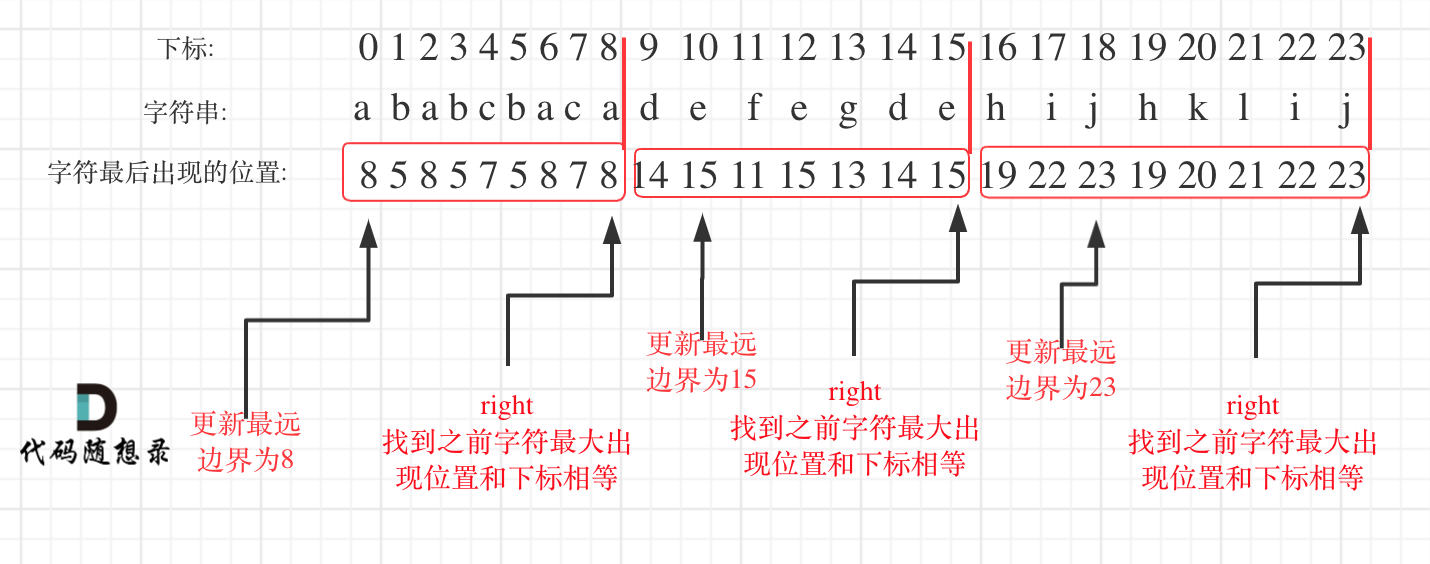参与本项目,贡献其他语言版本的代码,拥抱开源,让更多学习算法的小伙伴们收益!
字符串 S 由小写字母组成。我们要把这个字符串划分为尽可能多的片段,同一字母最多出现在一个片段中。返回一个表示每个字符串片段的长度的列表。
示例:
- 输入:S = "ababcbacadefegdehijhklij"
- 输出:[9,7,8] 解释: 划分结果为 "ababcbaca", "defegde", "hijhklij"。 每个字母最多出现在一个片段中。 像 "ababcbacadefegde", "hijhklij" 的划分是错误的,因为划分的片段数较少。
提示:
- S的长度在[1, 500]之间。
- S只包含小写字母 'a' 到 'z' 。
一想到分割字符串就想到了回溯,但本题其实不用回溯去暴力搜索。
题目要求同一字母最多出现在一个片段中,那么如何把同一个字母的都圈在同一个区间里呢?
如果没有接触过这种题目的话,还挺有难度的。
在遍历的过程中相当于是要找每一个字母的边界,如果找到之前遍历过的所有字母的最远边界,说明这个边界就是分割点了。此时前面出现过所有字母,最远也就到这个边界了。
可以分为如下两步:
- 统计每一个字符最后出现的位置
- 从头遍历字符,并更新字符的最远出现下标,如果找到字符最远出现位置下标和当前下标相等了,则找到了分割点
如图:
明白原理之后,代码并不复杂,如下:
class Solution {
public:
vector<int> partitionLabels(string S) {
int hash[27] = {0}; // i为字符,hash[i]为字符出现的最后位置
for (int i = 0; i < S.size(); i++) { // 统计每一个字符最后出现的位置
hash[S[i] - 'a'] = i;
}
vector<int> result;
int left = 0;
int right = 0;
for (int i = 0; i < S.size(); i++) {
right = max(right, hash[S[i] - 'a']); // 找到字符出现的最远边界
if (i == right) {
result.push_back(right - left + 1);
left = i + 1;
}
}
return result;
}
};- 时间复杂度:$O(n)$
- 空间复杂度:$O(1)$,使用的hash数组是固定大小
这道题目leetcode标记为贪心算法,说实话,我没有感受到贪心,找不出局部最优推出全局最优的过程。就是用最远出现距离模拟了圈字符的行为。
但这道题目的思路是很巧妙的,所以有必要介绍给大家做一做,感受一下。
class Solution {
public List<Integer> partitionLabels(String S) {
List<Integer> list = new LinkedList<>();
int[] edge = new int[26];
char[] chars = S.toCharArray();
for (int i = 0; i < chars.length; i++) {
edge[chars[i] - 'a'] = i;
}
int idx = 0;
int last = -1;
for (int i = 0; i < chars.length; i++) {
idx = Math.max(idx,edge[chars[i] - 'a']);
if (i == idx) {
list.add(i - last);
last = i;
}
}
return list;
}
}class Solution:
def partitionLabels(self, s: str) -> List[int]:
hash = [0] * 26
for i in range(len(s)):
hash[ord(s[i]) - ord('a')] = i
result = []
left = 0
right = 0
for i in range(len(s)):
right = max(right, hash[ord(s[i]) - ord('a')])
if i == right:
result.append(right - left + 1)
left = i + 1
return resultfunc partitionLabels(s string) []int {
var res []int;
var marks [26]int;
size, left, right := len(s), 0, 0;
for i := 0; i < size; i++ {
marks[s[i] - 'a'] = i;
}
for i := 0; i < size; i++ {
right = max(right, marks[s[i] - 'a']);
if i == right {
res = append(res, right - left + 1);
left = i + 1;
}
}
return res;
}
func max(a, b int) int {
if a < b {
a = b;
}
return a;
}var partitionLabels = function(s) {
let hash = {}
for(let i = 0; i < s.length; i++) {
hash[s[i]] = i
}
let result = []
let left = 0
let right = 0
for(let i = 0; i < s.length; i++) {
right = Math.max(right, hash[s[i]])
if(right === i) {
result.push(right - left + 1)
left = i + 1
}
}
return result
};

